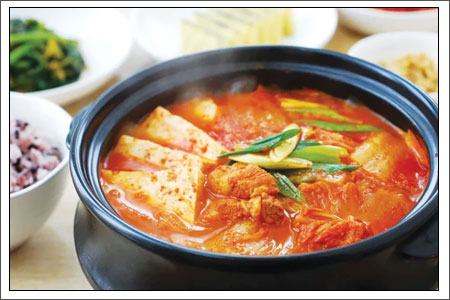Introduction
Kimchi Jjigae, also known as Korean Kimchi Stew, is one of the most beloved comfort foods in Korea. Made with aged kimchi, pork, tofu, and a flavorful broth, it is a dish that warms the body and soul. Its spicy, savory taste and rich aroma make it a staple in Korean households.
Kimchi Jjigae is often called the ultimate Korean comfort food. Whether enjoyed on a cold winter day or as a hearty family meal, it brings people together around the table with warmth and satisfaction.
Historical Background of Kimchi Jjigae
The origins of Kimchi Jjigae trace back to when Koreans began using aged kimchi as a cooking ingredient. Fermented kimchi, which becomes sour over time, was transformed into a stew with pork and other ingredients, creating a dish that minimized waste while maximizing flavor.
Kimchi Jjigae is more than just a stew; it is a dish that carries generations of tradition and remains a comfort food for countless Korean families.
This resourceful approach reflects the creativity and resilience of Korean cuisine, turning simple and affordable ingredients into a meal loved by generations.
Cultural Significance of Kimchi Jjigae
Food in Korea is never just food—it represents family, tradition, and community. Kimchi Jjigae is commonly shared at home as a family meal, and it is also served in Korean restaurants as a symbol of home-style cooking.
It is especially popular because of its versatility. Families adapt it with whatever protein or vegetables they have on hand, making it both economical and personal. Sharing a pot of Kimchi Jjigae creates a sense of warmth, closeness, and comfort.
Kimchi Jjigae is one of the most common dishes served in Korean homes, often appearing on the table several times a week. For many families, it represents warmth, economy, and familiarity. Leftover kimchi that becomes too sour for other dishes finds new life in Kimchi Jjigae, turning what might be discarded into a nourishing meal. This everyday role reinforces its identity as Korea’s ultimate comfort food.
Variations of Kimchi Jjigae
While the classic version uses pork, there are many popular variations of Kimchi Jjigae across Korea:
-
Pork Kimchi Jjigae: The most common, made with fatty pork belly that enriches the broth.
-
Tuna Kimchi Jjigae: Canned tuna is added for a lighter but savory flavor.
-
Tofu Kimchi Jjigae: A vegetarian-friendly option that highlights soft, silky tofu.
-
Seafood Kimchi Jjigae: Shrimp or clams add a unique depth of taste.
These variations prove that Kimchi Jjigae is not a fixed recipe but a flexible dish that adapts to different tastes and lifestyles.
Health Benefits of Kimchi Jjigae
Beyond its comforting taste, Kimchi Jjigae is also full of health benefits. Kimchi itself is rich in probiotics, fiber, and vitamins, supporting digestion and gut health. The addition of garlic, chili peppers, and onions provides antioxidants and anti-inflammatory properties.
Many Koreans believe that a steaming bowl of Kimchi Jjigae helps the body recover from fatigue, warms the stomach, and refreshes the appetite. This is why Kimchi Jjigae is not only delicious but also considered a natural remedy in Korean cuisine.
Modern nutrition studies also highlight the role of kimchi in strengthening immunity and reducing inflammation. In this way, Korean Radish Kimchi represents the balance of taste and health in Korean cuisine.
Many people also note that Kimchi Jjigae helps digestion after a heavy meal, making it not only tasty but also practical for everyday health.
Global Popularity of Kimchi Jjigae
As Korean food gains worldwide attention, Kimchi Jjigae has become a favorite among international fans of Korean cuisine. It is now served in Korean restaurants across the United States, Europe, and Asia.
Some chefs even use Kimchi Jjigae as inspiration for fusion cooking, incorporating its bold flavors into pasta, stews, and even Western-style casseroles. While traditionalists may prefer the classic version, these innovations prove that Kimchi Jjigae has global appeal. From Los Angeles to London, Kimchi Jjigae continues to gain fans who appreciate its bold flavors and cultural depth.
Kimchi in Korean Culture
Korean Radish Kimchi (Kkakdugi)
Wikipedia: Kimchi Jjigae
Kimchi Jjigae is more than just a dish—it is an expression of Korean daily life. Families often gather around the table with a steaming pot of Kimchi Jjigae, sharing stories while enjoying its spicy warmth. The dish changes slightly depending on ingredients, such as pork, tofu, or tuna, but the heart of Kimchi Jjigae is always the well-fermented kimchi that gives it a deep and tangy flavor. Many Koreans even say that old kimchi makes the best Kimchi Jjigae, proving that time is the secret ingredient. Today, restaurants and home cooks alike celebrate Kimchi Jjigae not only as comfort food but also as a symbol of Korea’s enduring culinary heritage.
Outside Korea, international chefs experiment with Kimchi Jjigae in creative ways. Some add seafood such as shrimp or clams, while others substitute chicken or beef for pork. Vegan versions replace fish sauce with soy sauce or miso, making Kimchi Jjigae accessible to more people. These adaptations may differ from the traditional version, but they prove how versatile and inspiring Kimchi Jjigae has become worldwide.
Because of its comforting taste and cultural depth, Kimchi Jjigae continues to stand out as one of the most iconic Korean dishes worldwide.
Conclusion
From its humble beginnings to its role as a global comfort food, Kimchi Jjigae embodies the essence of Korean cooking—spicy, hearty, and deeply cultural. It tells the story of Korea’s creativity and resilience, while also bringing families together across generations.
In every variation, Kimchi Jjigae remains the ultimate Korean comfort food, connecting people through flavor and tradition. Whether enjoyed at home in Seoul or at a Korean restaurant abroad, Kimchi Jjigae is more than just stew—it is a taste of Korea’s heart and soul.
For anyone exploring Korean cuisine, starting with Kimchi Jjigae is the perfect way to experience authentic flavor and tradition.

